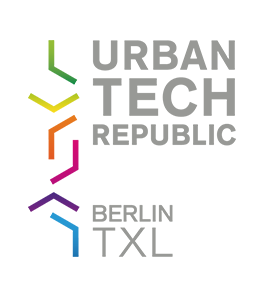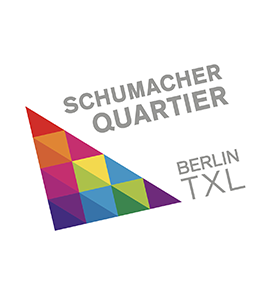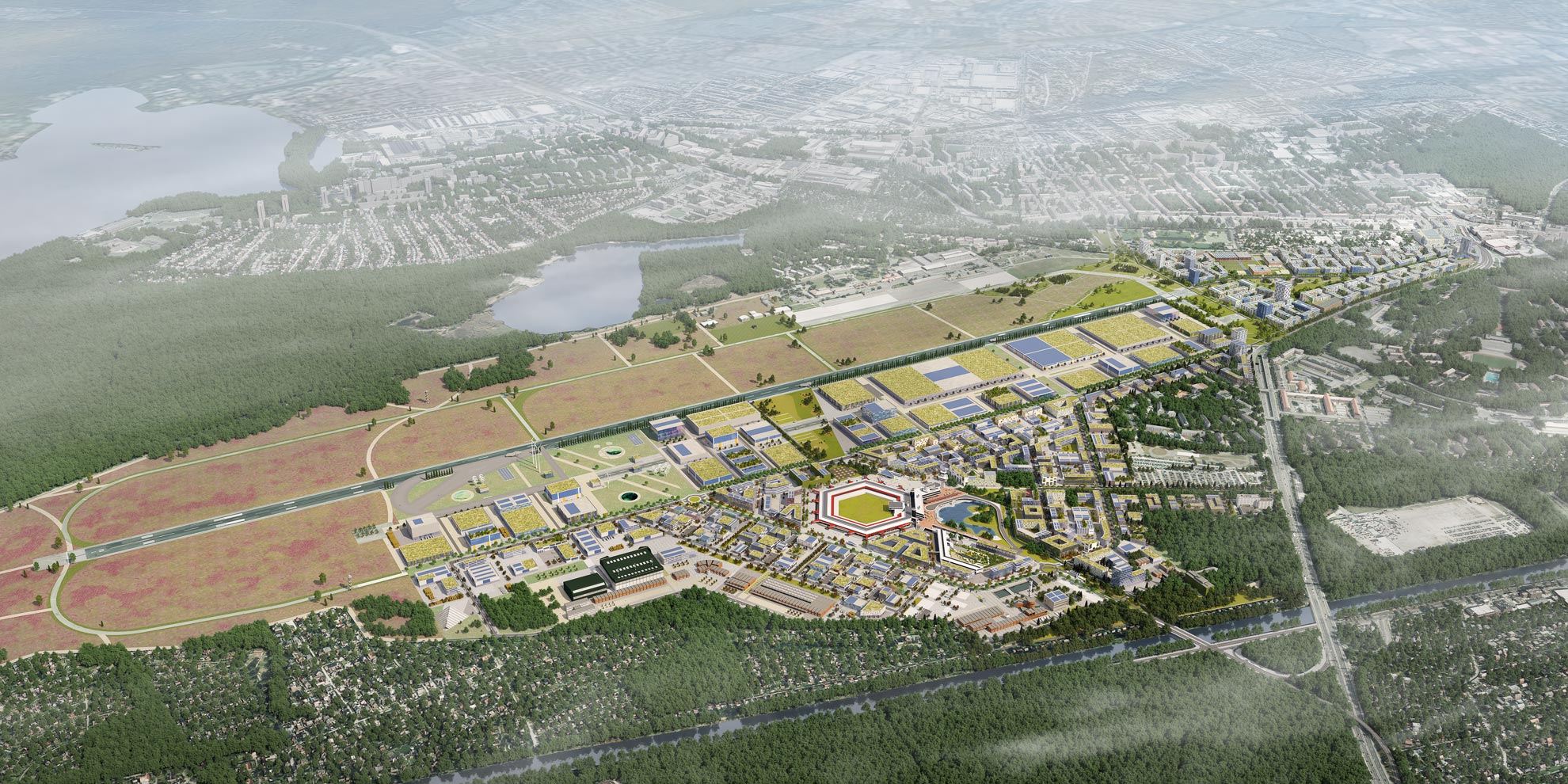FAQ
What is happening on the grounds of the former Tegel Airport?
The following are the developments now emerging on the five square kilometer site:
Berlin TXL – The Urban Tech Republic
In the Urban Tech Republic as many as 1,000 large and small businesses with 20,000 employees will work in research, development, and production. And more than 2,500 students will move into the former terminal building along with the prestigious Berliner Hochschule für Technik University. In total around 5,000 students will populate the Berlin TXL campus. Berlin TXL will focus on what keeps the 21st century’s growing major cities alive:
- the efficient use of energy,
- eco-friendly mobility
- clean water
- recycling
- sustainable construction and application of new materials
- networked control of systems
Areas for industry, trade and science: 39 ha campus, 70 ha business belt and 82 ha industrial park (Berlin’s largest contiguous inner-city industrial site).
Users of the Urban Tech Republic will be start-ups, students, scientists and established companies. Two key anchor tenants have already been identified: Berliner Hochschule für Technik University of Applied Sciences and Berlin Fire and Rescue Service Academy
Up to 1,000 companies can locate here; up to 20,000 jobs are to be created.
Berlin TXL – Schumacher Quartier
Schumacher Quartier closes the historic gap in the western sector of Kurt-Schumacher-Platz. Schumacher Quartier will provide upwards of 5,000 homes for more than 10,000 people, together with the corresponding amenities such as schools, daycare centers, shopping facilities, and lots of greenery. A further 4,000 homes are planned for the neighboring districts of Cité Pasteur and TXL Nord.
As it will be a sustainable and socially diverse area, Schumacher Quartier will make an important contribution to the strategy for housing construction and urban development in the German capital. In a Charter all partners involved have agreed upon seven guidelines for the development of Schumacher Quartier:
- Urban living spaces
- Housing for everyone
- Urban green space and public areas
- Urban green space and public areas
- Climate-friendly and water-sensitive urban development
- District with environmentally-friendly mobility guaranteed
- Communication, participation, and transparency
Urban Heathland
The extensive landscape area of the Tegel urban heathland forms a bridge between the city and nature, and completes the pioneering concept of Berlin TXL. The state-owned company Grün Berlin GmbH is taking on the task of gradually transforming the former airfield and runway.
When does construction work begin?
After the acquisition of the site in August 2021 preparatory construction measures began, in particular the clearance of explosive ordnance. After eliminating any dangerous waste, the first civil engineering work started in 2022/2023, as well as the restoration and reconstruction work on the existing buildings in the Urban Tech Republic. This is followed by construction of the first residential units and of the education campus in Schumacher Quartier. Start of construction is expected to be in 2026.
When will the construction work be completed?
We are expecting an implementation period of around 20 to 30 years.
We are expecting an implementation period of around 20 to 30 years. The education campus and the first residential buildings in Schumacher Quartier are expected to be finished by 2028/29; the final ones in the 2030s. Construction in the Urban Tech Republic will probably last another ten years, but it may also take less or even more time, depending on the economic situation. The research and industrial site will never be truly “finished” – it will keep evolving quickly and easily, with its face also constantly changing.
Will the airport buildings disappear?
No, that won’t happen. Large parts of the existing buildings are listed buildings and will form the nucleus of the future Urban Tech Republic. The iconic ensemble of buildings will be preserved for Berlin. Only lower grade parts without protected status will be removed, for example containers, tanks above ground and such like, or buildings that do not form part of the historic architectural ensemble.
How will the tower and terminals continue to be used?
The Berliner Hochschule für Technik will move into central Terminal A – in all likelihood in 2027. Terminal B is planned as start-up and event center. A technology center with laboratories, offices and workshops is being built in Terminal D. There are numerous ideas for the tower, but a decision about its subsequent use has not yet been made.
Terminal C will be dismantled. This provisional annex, dating from 2007, is neither part of the historic ensemble nor a listed building.
Who can acquire pieces of property on the site? And at what kind of prices?
All future properties in Berlin TXL are available to investors as part of leasehold estate contracts. In this way, the State of Berlin retains ownership of the properties.
Companies and institutions conforming to profile in the field of urban technologies can acquire a leasehold estate contract for properties in the Urban Tech Republic. The ground rent is determined by the type and degree of the future use and the corresponding stipulations of the State of Berlin, as is also the term of leasehold estate contracts.
Half of the area in Schumacher Quartier goes to state-owned housing associations. The other half will be offered, also as part of the awarding of leasehold estate contracts, to housing cooperatives, construction groups, and providers tendering for special types of housing (e.g. student residences). Further information about Schumacher Quartier can be found here: https://schumacher-quartier.de/en/
The landscape area, the landscape park and the district park in Schumacher Quartier are available to the general public. No leasehold estate can be acquired here.
When can something be rented? And for how much?
Urban Tech Republic: First spaces in the existing buildings of the former airport are already able to be leased in tandem with the construction process. Some buildings are still to be renovated before their long-term further use. Rents will be based on the commercial leasing in the respective market situation. In the start-up and technology centers that are being created, the spaces are being made available to eligible start-up companies under more favorable conditions.
Schumacher Quartier: The first residential units are expected to be ready to occupy starting in 2028/29 and will be leased out by the state-owned housing associations and cooperatives. The proportion of subsidized rents will be approximately 35-40 per cent in the district.
Will the bus connection to the airport continue to exist?
- Bus line 109 goes to the new Urban Tech Republic terminus, which is also the meeting point for the site tours. You can find the bus route to the Urban Tech Republic here.
- With continued development of the Urban Tech Republic and Schumacher Quartier, new connections to the Public Transport Network can be expected. In the future, there will also be a tram connection.
What adverse effects are expected?
The former Tegel Airport is a major construction site, which also has repercussions on its surroundings and the neighborhood. We would like to keep these as small as possible and at the same time we ask for your understanding for necessary measures.
The construction site access road is located at the former airport access road on Saatwinkler Damm (south access road). There will be a second one on Kurt-Schumacher-Damm in the future.
The site will be searched by us for explosive ordinance from the Second World War. If what is called a ‘dud’ is discovered, there may be temporary street closures and, if need be, even evacuations in the surrounding area.
Meteorstrasse will be converted into an urban road with new sidewalks and bike paths, grass verges planted with trees, as well as two lanes in both directions. Here also restrictions are to be expected during the construction work.
Naturally we will inform you in a timely manner about any upcoming measures.
As part of the Integrated Urban Development Plan (German acronym ISEK), various measures are being implemented for development of the area close to Tegel Airport. You will find more detailed information about this on the website of the Senate Administration for Urban Development, Construction and Housing.
How much longer will the Federal Armed Forces ("Bundeswehr") be on the grounds?
Parts of the “TXL North” development site will continue to be used by the helicopter squadron of the Federal Armed Forces Air Wing. (“Bundeswehr-Flugbereitschaft”) Planning for this quarter is still in its infancy. We are currently working on the feasibility analysis.
What does the project development cost and who pays for it all?
Berlin TXL is being financed from several different public and private sources: From Berlin’s budgetary resources, subsidies from the EU and the Federal Government, and the marketing and leasing of premises. In all we are counting on total investments of around eight billion euros, the major portion of which will be private investments.
How can I participate with my company in the implementation?
Tegel Projekt GmbH is a public corporation and awards the contracts as part of public tender procedures that, depending on their size, are published on the stipulated platforms, for example on the State of Berlin’s tendering platform. Join in our public tenders – we look forward to working with you!
In the future, when so many people are out and about in the residential district and in the Urban Tech Republic, won't the streets, the public transport system and their surroundings then be congested?
Quite the opposite: It’s rather that the traffic will be lighter and the environment will be freed up. As a comparison: Before the slump in air traffic as a consequence of the Corona crisis, every day there were more than 70,000 people en route to the airport – via the bottleneck that was the airport feeder road. In the future as many as 20,000 people will work in the area and around 10,000 people will live there. In addition, an innovative mobility concept has been developed for Berlin TXL.
Won't rents go up in the neighborhood in the future? Isn't there a fear of gentrification? Ist Gentrifizierung zu befürchten?
After the closure of the Tegel Airport almost 30,000 residential units will be able to be built on the actual grounds and in their extended radius, which will bring considerable relief to the situation in the Berlin housing market. Moreover, in Spandau and Reinickendorf consideration is being given to environmentally protected areas in order to keep the appreciation pressure low after closure of the airport. In addition, the tools of the Federal Government (rent curbs) will take effect here. Furthermore, for the environs of the airport site a plan known as the Integrated Urban Development Concept (German Acronym ISEK) “Berlin TXL Surrounding Area” has been developed. The objective is to network the Urban Tech Republic and Schumacher Quartier as closely as possible with the existing city districts all around.
Are the grounds accessible to the public?
Not in the short term – when air traffic stopped, the grounds were closed. In our Infocenter Berlin TXL in Building V you are able to obtain information, visit exhibitions or participate in events, but also get the opportunity to book the premises for your event.
To ensure that many people can enjoy this special place, guided tours of the grounds take place regularly. The two-hour outdoor walks can be booked at https://museumsdienst.berlin. Individual existing areas are also used for events.
Outside the tours the area is a huge construction site with the appropriate security to prevent unauthorized access. As soon as each construction phase is finished, that section will then also be accessible to the public.
After explosive ordnance clearances and site remediation, the extensive landscape space north and west of the Urban Tech Republic will be opened to the general public in the next few years in succession. The 200-hectare landscape zone which will be developed by Grün Berlin.
What new leisure facilities will there be?
Quite a lot. In addition to the huge landscape zone, access to which will be free, numerous attractive sports and exercise facilities are planned: playgrounds, multi-purpose sports facilities, and fitness and health stations along jogging paths. On the surface of the landing strip and the taxiway there will be a roller derby track, a street skateboarding park, a streetball facility, a bicycle parcours, and a calisthenics parcours, among many other offerings. On the green spaces of the park there are plans for a rock-climbing gym, a soccer field, and an area for frisbee golf, as well as an outdoor fitness area.
All sports and play areas in the district and landscape park will be designed taking into account gender guidelines and with as few barriers as possible in order to promote communal play. With regards to sports and playing facilities, shade roofs and seating facilities, picnic tables and informal bleachers have been arranged creating a wide variety of places to meet.


